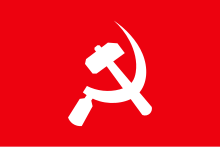| Naxalbari Uprising | |||||||
|---|---|---|---|---|---|---|---|
| Part of the Cold War and Naxalite Insurgency | |||||||
 The South Asian communist banner | |||||||
| |||||||
| Belligerents | |||||||
|
Supported by: |
Supported by: | ||||||
| Commanders and leaders | |||||||
|
|
| ||||||
| Units involved | |||||||
|
Indian Police Service West Bengal Police |
| ||||||
| Casualties and losses | |||||||
| 1 police died | 11 rebels died | ||||||
The Naxalbari uprising was an armed peasant revolt in 1967 in the Naxalbari block of Siliguri subdivision in Darjeeling district, West Bengal, India. It was mainly led by tribals and the radical communist leaders of Bengal and further developed into the Communist Party of India (Marxist–Leninist) in 1969. The armed struggle became an inspiration to the Naxalite movement which rapidly spread from West Bengal to other states of India creating division within the Communist Party of India (Marxist) - India's primary communist party.
Origins
Main article: Communist Party of India (Marxist–Leninist)The uprising occurred during the height of the Sino-Soviet split, which was causing turmoil within the communist organisations in India and the rest of the world. The leader and ideologue of the uprising Charu Majumdar theorised that the situation was appropriate for launching an armed People's war in India following the Chinese Communist Revolution, Vietnam War and Cuban Revolution. Charu Majumdar wrote the Historic Eight Documents which became the foundation of the Naxalite movement in 1967.
Timeline
The communists in 1965-66 already controlled territory in the Naxalbari region. The so-called "Siliguri group" called for initiating an armed struggle, which started the uprising. Many peasant cells were created throughout the region. On 3 March 1967 just a day after the united front had sworn in ministers in West Bengal, some 150 peasants armed with bows and spears, took 300 maunds of paddy or around 11000 kg of paddy and started seizing land. The peasants were enraged that the CPI(M) did not retain workers in the party. By 18 March the peasants started seizing land from jotedars (landlords who owned large plots of land in the region). Peasant committees were set up throughout the region within four months. The first clash occurred between the peasants and landlords when a share-cropper, Bigul Kisan, was beaten up by landlord gentries. Following this, peasant committees seized land, foodgrains and arms from the landlord gentries, leading to violent clashes. The government started mobilizing the police forces to deal with the uprising.
The inspector of Jharugaon village was killed by peasant committee members. In retaliation, the police opened fire which resulted in the death of nine women and one child on 25 May 1967. By June the peasant committees gained hold in the regions around Naxalbari, Kharibari and Phansidewa seizing lands, ammunition and food grains from the jotedars. The tea garden worker around the Darjeeling region participated in strikes supporting the peasant committees. The upheaval sustained till 19 July when the paramilitary forces were sent by the government. Leaders like Jangal Santhal were arrested. Some of them like Charu Majumdar went underground. And others like Tribheni Kanu, Sobham, Ali Gorkha Majhi, and Tilka Majhi were killed.
Recognition and aftermath
Main article: Naxalite–Maoist insurgencyThe Chinese Communist Party's relations with the Communist Party of India (Marxist) deteriorated following CCP support of the uprising. Many members of the CPI(M) who supported the uprising were expelled, such as Charu Majumdar, Souren Bose, Mahadeb Mukherjee and Dilip Bagchi. Expelled communists later on organised themselves into one organisation, the All India Coordination Committee of Communist Revolutionaries (AICCCR), which later developed into the CPI(ML). CPI(ML) remained the centre of the Naxalite movement till 1975. A large number of enthusiastic youth joined the movement. Although the uprising was suppressed, it remained a landmark in Indian politics which led to several other similar kind of movements in parts of Bihar and began the ongoing Naxalite–Maoist insurgency.
See also
References
- Singh, Prakash. The Naxalite Movement in India. New Delhi: Rupa & Co., 1999. p. 24.
- ^ "History of Naxalism". Hindustan Times. 15 December 2005. Archived from the original on 22 February 2018. Retrieved 2 March 2018.
- Shashi Shekhar (21 May 2017). "50 years of Naxalbari: Fighting for the right cause in the wrong way". Hindustan Times. Archived from the original on 21 May 2017. Retrieved 2 March 2018.
- ^ "The Naxalbari Uprising". 30 years of Naxalbari. Archived from the original on 31 October 2010. Retrieved 2 March 2018.
- Nadeem Ahmed. "Naxalite Ideology: Charu's Eight Documents". The Hindustan Times. Archived from the original on 21 December 2016. Retrieved 2 March 2018.
- "Naxalbari Movement (1967) - IAS Site". 18 December 2022. Retrieved 25 December 2022.
- "Spring Thunder Over India". People's Daily. marxists.org. Retrieved 21 December 2016.